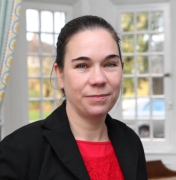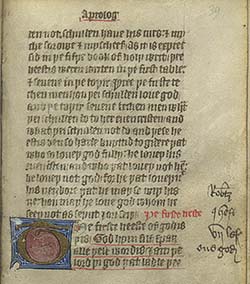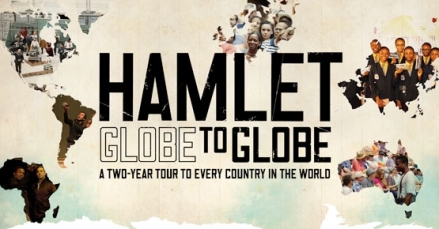Early Modern Book Collectors and the Circulation of Women’s Texts
8 February | Trinity Long Room Hub | 16:00
A public lecture by Dr Marie-Louise Coolahan (NUIG) as part of the Trinity Centre for Early Modern History Research Seminar Series 2015-16.

8 February | Trinity Long Room Hub | 16:00
A public lecture by Dr Marie-Louise Coolahan (NUIG) as part of the Trinity Centre for Early Modern History Research Seminar Series 2015-16.


A public lecture by Dr Margaret Connolly (University of St Andrews) during her term as a Visiting Research Fellow at the Trinity Long Room Hub in collaboration with the School of English.
Bio: Dr Margaret Connolly is an Honorary Research Fellow in the School of English at the University of St Andrews. Dr Connolly’s field of study is medieval English literature, with a particular emphasis on the manuscript contexts in which Middle English texts survive. She has worked on both scribal production and reader reception, and has edited and catalogued medieval texts.
Abstract: This lecture will consider ways in which early modern readers continued to use old medieval books, taking as its focus a group of eight fifteenth-century manuscripts owned by a single English gentry family in the sixteenth century. Although these volumes were used in various ways (as a repository for family records; as a safe place to preserve important material; as a source of practical household information; and as a professional lawyer’s manual), primarily, Dr Connolly will argue, they were used quite simply as books, that is, that they were read. Many of the original texts in these manuscripts are of a devotional nature, and a special point of interest is the disjunction between these textual products of a wholly Catholic age and the reformist religious environment that their Tudor readers inhabited, especially after the 1530s. The lecture will consider evidence of annotations, comments, and other markings (and also places left unmarked), in order to try to interpret the nature of these later readers’ engagement with their old medieval books.

‘Brand Luther: 1517, Printing and the Making of the Reformation’
Trinity Long Room Hub, 18 January, 4pm
A public lecture by Prof Andrew Pettegree (St Andrews) during his Visiting Research Fellowship at the Trinity Long Room Hub. This lecture is part of the Trinity Centre for Early Modern History Research Seminar Series 2015-16.

Hamlet, Shakespeare’s Globe, dir. Dominic Dromgoole, Bill Buckhurst
Smock Alley Theatre, Matinee, Jan 2nd
As this Globe production of Hamlet reaches Ireland as the 155th stop in its global tour, you might expect a lack of freshness from the actors. The rousing, frenetic and funny Hamlet presented to Smock Alley audiences defied such expectations.
Flexibility is the name of the game with this production, as audiences are asked to accept Amanda Wilkin in a floor-length robe to be Queen Gertrude, while later transformed to a grave-digger with leather cap and mattock in hand. Indeed the same actress that matinee audiences saw as Gertrude would play Ophelia later that evening, while the lead role of Hamlet revolved from Ladi Emeruwa to Naeem Hayat. Doubtless such varying of roles helps to keep the language and action fresh for a 2 year tour, while also demanding huge variety and dexterity from the actors. For the set, packing crates remain onstage throughout, with small repositionings used to transform Elsinore’s battlements to Gertrude’s closet. Meanwhile a line of clothes hooks at the back held weapons, robes and instruments as required, which would be donned or doffed in full view of the audience for the play’s many many doublings.
The production’s overall aesthetic could be described as hipster-gypsy. Costumes sported lots of tweed waistcoats and braces, complemented by worn-out brown leather boots that really did look like they were made for walking. While not looking out of place in Smock Alley, this seemed designed to help Shakespeare blend in with his surroundings on the tour’s many far-flung appearances, from an archaeological site in Austria to Za’atari, Jordan’s Syrian refugee camp. Indeed the programme note was keen to emphasise how this was a return to the touring traditions of early modern playing, both in England and abroad.
Music. Never before have I seen a Hamlet so full of music. The decision to cast actors who could also hold a tune or play an instrument (standard Globe practice for touring shows) has the dual advantage of making the company more compact, while also carrying the audience gently from scene to scene. Instruments varied from the unearthly bowing of a cymbal on the ghost’s appearance to accordions and tin whistles accompanying the arrival of the players. This enlivened the 2 hour 45 minute running time, enhancing the overall folk atmosphere.
For me, the ‘tragedians of the city’ were a personal highlight. Hamlet’s play-within-a-play is well-known for its meta-theatricality, and this was given added richness in a production where the evidence of touring is never hidden from view. The makeshift curtain used for the Mousetrap had elsewhere been used to hide Claudius and Polonius during ‘To be or not to be’, and would go on to serve as the fatal arras of that ‘wretched, rash, intruding fool’. The curtain also facilitated lightning quick changes that allowed Claudius and Gertrude to double as the Player King & Queen, with Hamlet attentively observing both spectacles from the sidelines. In a trimmed-down touring production I found the choice to retain both dumbshow and spoken version intriguing, which on reflection made complete sense considering the company are so often performing for non-Anglophone audiences. And thankfully so, as the dumbshow’s melodramatic gestures and rhythmic beat had the entire audience hypnotised, leading to spontaneous applause.
Seated on the extreme stage-left, I was surprised with how front-facing the blocking appeared to be. When Hamlet interacted with other actors the action was fluid and dynamic, for example during the swearing scene following the ghost’s revelations. Yet for soliloquies Ladi Emeruwa frequently took up position down-stage centre, hardly turning to engage flanking audiences. In terms of focus, this felt very much like an ensemble production rather than a star-vehicle (unlike other Hamlets I could name). John Dougall was a reasonable Claudius, but to my mind was even stronger as the old ham player, acting out the Pyrrhus speech with cane in hand. The versatility of Keith Bartlett as Polonius, grave-digger, priest and soldier was admirable, while Matthew Romain’s turn as Osric stole the scene (the same actor made a great Edmund/Tom o’ Bedlam in the Globe’s previous touring production of King Lear).
In terms of text, this production favoured clarity over nuance, which is by no means a criticism. Cuts were clever and unobtrusive, while room was made for some first quarto material such as Hamlet’s advice about clowns rehearsing tired jests like ‘your beer is sour’ (with an improvised Guinness joke), and Horatio’s final instruction to let a ‘scaffold be reared up in the marketplace’. The final scene showed beautiful choreography, first for the duel between Hamlet and Laertes, and then for the transition from catastrophe to jig. Jennifer Leong’s Ophelia first raised her brother Laertes for a slow stately dance, then dancing with Keith Bartlett who had played Polonius, before resurrecting Ladi Emeruwa’s Hamlet. It had never struck me before how much Ophelia is the thread that connects all the major characters, and her interaction with each in turn was – to choose a word equally suited to early modern performance and twenty-first century touring – moving.
Review by Derek Dunne
For more on this tour see globetoglobe.shakespearesglobe.com